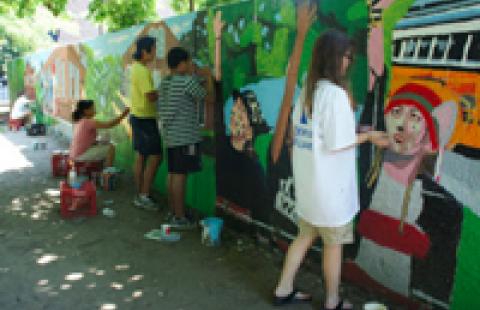What were the specific goals of this creative economy project? Describe the community development challenge or opportunity that your project was designed to address:
After many years of community advocacy, a long-term plan to connect the Minuteman Bike Path to the paths along the Charles River through Watertown was underway. A 210 foot concrete wall along an existing segment of the path presented an opportunity to create visual excitement and generate enthusiasm for using the path and introduce residents to the process of incorporating public art into the fabric of the town.
Goals:
• Create a high quality and enduring public art installation with great community impact
• Transform a blank concrete wall into an exciting and welcoming feature of the path
• Artistically reflect the culture of Watertown
• Generate community involvement
• Provide a basis for further public/private initiatives and public art projects.
If the goals change over time, please describe how:
Although the goals of the project did not change substantially, the goals of the ad hoc committee formed to execute the plan did. Watertown is experiencing a development boom at present. Further, the town is engaged in a Comprehensive Planning process that will map the shape and direction of town growth in the decades to come. Watertown possesses some notable cultural resources, including the Arsenal Center for the Arts, the Watertown Children’s Theatre, the Armenian Museum, a growing number of galleries and an active population of artists, writers, musicians and filmmakers. Influenced in part by these factors, the committee began to envision an ongoing role in the community for an entity that would advocate, create partnerships and marshal the resources to advance public art projects in tandem with this growth.
Who was involved in this project and what did they do? (be sure to include the partners from outside of the creative sector and how local voices were included):
For the project, an oversight committee was convened comprising representatives of Watertown Citizens for Environmental Safety, the Bicycle and Pedestrian Committee, Community Development and Planning Department of Watertown, Sustainable Watertown and the Arsenal Center for the Arts. The oversight committee formed a partnership with the Watertown Cultural Council, which supported the project with a grant and agreed to act as fiscal sponsor for the purpose of receiving funds. The Marketing Vice President of the Watertown Savings Bank served as both advisor and lead donor. Additional support was secured from the property owner whose retaining wall was the site of the artwork and from the Boys and Girls Club and Watertown High School faculty, who helped to recruit student interns to execute the project with a professional artist. The Watertown Recreation Department agreed to be responsible for the student interns, thereby taking responsibility for screening and hiring and liability in the event of injury. Local businesses contributed money and in-kind and pro bono resources.
How does this project relate to a larger community development strategy?
Public art is incorporated in the draft Comprehensive Plan in two sections. In the Economic Development section, Goal 5, Section D states: “Provide and promote the arts to enhance the sense of place and quality of life for all residents.” Strategies include:
1. Require public art to be incorporated into projects and public spaces and that a maintenance/conservation plan be developed for each installation.
2. Pursue a percentage for the Arts and other funding sources related to public art.
3. Create a public art and culture committee to participate in site plan review, distribute public funds for the arts and facilitate the placement and advocacy of public art.
In the Historic, Cultural and Art Resources section, Goal 3 is “Support artistic and cultural assets and place-making activities.” Section C states: “Develop a public arts program to foster lively and attractive streetscapes.” Strategies include:
1. Establish a public art trust for funding purposes
2. With neighborhood input, identify sites for permanent art installations, such as public buildings parks, public spaces, and transit structures
3. Collaborate with owners of vacant parcels, parks, empty storefronts and buildings to erect temporary art installations
4. Install public art as a required part of significant new public and private development.
5. Develop and fund a conservation plan for public art in civic spaces.
6. Create a public art and culture committee to participate in site plan review, distribute public funds for the arts and facilitate the placement and advocacy of public art.
The public art committee contributed significantly to the shaping of this language. The 2013 pathway mural and a 2014 project have become the starting points of a comprehensive public art effort supported by the Community Development and Planning Department and city councilors, as well as residents.
What projects or places, if any, inspired your approach to this creative economy project?
Many locales throughout Massachusetts and New England interpret public art in broad and inventive ways and incorporate public art throughout the urban landscape. Right next door to Watertown, Cambridge and Somerville are model communities in the integration of public art, including both permanent and temporary installations that contribute to their successful place making. The Cambridge Arts Council staff gave generously of its time, knowledge and resources to educate our oversight committee about the costs, process and timeframes of mural projects.
Our committee members are alert to examples of public art wherever we go, and are constantly expanding our definition of what public art is, from mosaic-covered streetlamp posts on St. Marks Place, NY, to holiday light installations in the squares of Cambridge to the 4th Plinth in Trafalgar Square.
